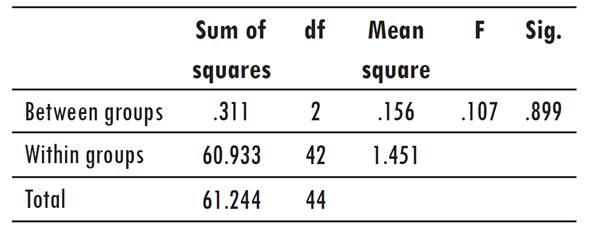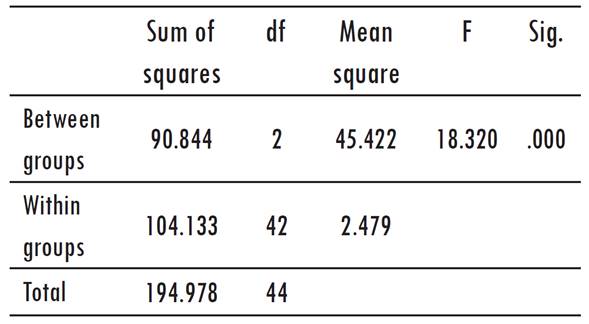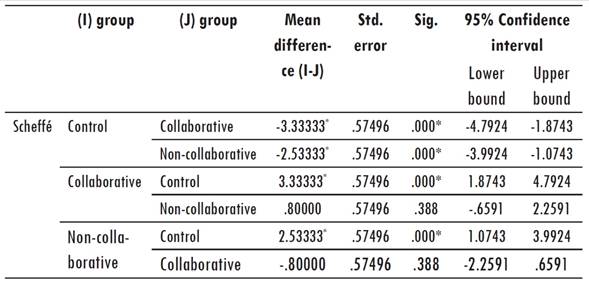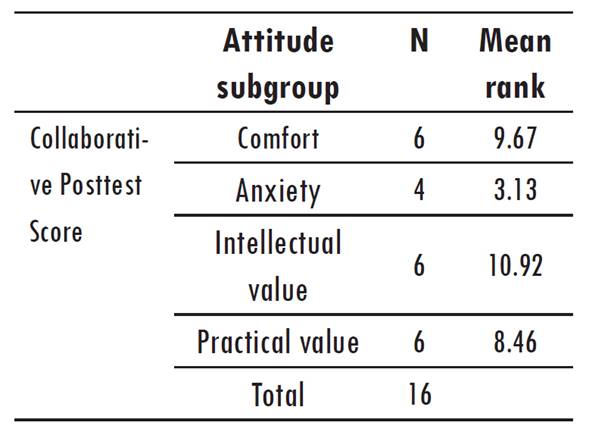Introduction
Reading has long been considered the most important skill in the context of English as a Foreign Language (EFL) in Iran. Traditional language teaching methods are teacher-oriented, and learners mainly focus on competing with each other on individualized reading activities and doing translation work and other exercises to learn vocabulary and grammar. Recently, however, educationalists turned their attention regarding effective teaching from teacher-oriented to learner-oriented approaches (Richards & Rodgers, 2001). Trends in the development of materials and teaching methods are shifting toward employing learner-oriented approaches to learning. These changes should be introduced with care, and sufficient consideration should be given to ensure the most appropriate learner-centered approach is chosen for a given educational setting. For example, communicative language teaching (CLT), which is very effective in boosting the learning of language skills, such as writing and reading, and sub-skills, such as grammar and vocabulary, might not work effectively if employed in classes whose students have low motivation to learn or are not socially and emotionally prepared for collaborative learning. Though CLT is proven as a useful method of language teaching, many studies have revealed that its success is not guaranteed (Deckert, 2004; Dordinejad, Ashouri, Hakimi, Moosavi, & Atri, 2011; Vaezi & Abbaspour, 2014).
The concept of learner-orientedness emphasizes the personal concerns of learners in language teaching and encourages learners to take an active and effective role in their own learning processes (Larsen-Freeman, 2000). One way to create a learner-oriented classroom in a reading course is to teach reading strategies (see Celce-Murcia, 1991; Clark & Silberstein, 1977; McNamara, 2007; Molelo & Cowieson, 2003). Reading strategies make the reading activity a learner-centered endeavor as they are concerned with the how of reading (Davis, 2010). Using quantitative and qualitative data analyses, Phakiti (2003) investigated the relationship of cognitive and metacognitive strategy use with reading test performance. A total of 384 Thai efl university students in a fundamental English course took an 85-item, multiple-choice reading comprehension achievement test followed by a cognitive-metacognitive questionnaire as a retrospective measure of strategy use. In addition, eight of them (four highly successful and four unsuccessful) were also selected for retrospective interviews. The results showed a positive relationship between the use of cognitive and metacognitive strategies and reading test performance and that successful test-takers employed metacognitive strategy more than the unsuccessful ones.
Even today, the reading activities in English courses in Iran are mostly based on the traditional method of focusing on translation, vocabulary and grammar. Only recently have there been changes in English course books to make them learner-centered and based on CLT claims. However, before the practicality of this movement goes under investigation in the Iranian educational system, researchers can investigate the necessity of employing the cooperative teaching approach to teach a course’s target skills when these skills are also strategy-based. As strategy-based instruction is learner-centered in itself (Nguyen & Gu, 2013), how much do we really need to employ another learner-centered approach simultaneously-namely, collaborative learning-to teach the desired skills effectively enough to ensure a significant improvement in comprehension is observed? This study investigates the effect of collaborative and non-collaborative approaches to the teaching of reading strategies on Iranian EFL learners' reading comprehension and attitude toward reading.
Theoretical framework
According to Clark and Silberstein (1977), students need to be taught strategies for effective reading comprehension. Janzen (1996) posited that reading strategy instruction helps to develop awareness about the reading process in students. Reading strategy instruction (RSI), first proposed by Rubin (1975), is a strategic approach to explicitly teaching reading strategies that aim at boosting students' text comprehension (Williams, 2002). Shokrzade (2010) studied the impact of metacognitive strategies and critical thinking ability on learner comprehension. Sixty EFL learners who were assigned to four groups were presented with the strategies of framing questions, gathering information, understanding arguments, and advancing arguments. The results of this study revealed that metacognitive strategy instruction had a positive impact on learners’ reading comprehension. He also found that there was a significant relationship between reading comprehension and critical thinking. Hence, he concluded that metacognitive strategies affected the relationship between reading comprehension and critical thinking.
Many approaches have been utilized to teach reading strategies: direct explanation; transactional strategy instruction, which combines direct explanation with the ability of teachers to facilitate discussion; and collaborative strategic reading (CSR), which combines reading strategy instruction with cooperative learning (Klingner & Vaughn, 1999). Another way to create a learner-oriented classroom in a reading course has been to use cooperative language learning (CLL) (Crandall, 1999). The literature review in this study examined both cooperative and collaborative learning through the lens of CLT. Meanwhile, Cuseo (1992), in Kaufman, Sutow, & Dunn, 1997) treated cooperative learning as a subcategory of collaborative learning, and Jacobs and Farrell (2003) equated them with each other when they said, "cooperative learning, also known as collaborative learning, offers many ideas for addressing various issues which arise when students work in groups". Cooperative learning is one of Grabe's (1991) seven guidelines for reading instruction, with Crandall (1999) adding that it creates interdependence in learners because success depends on the efforts of all members of the group in a cooperative activity. Using a set of comprehension strategies designed to improve understanding of expository texts, Klingner, Vaughn, Arguelles, Hughes, and Leftwich (2004) carried a study extending eight years of previous research using CSR. The researchers engaged five intervention and five control teachers from five different schools along with their students in order to examine the teachers’ yearlong use of CSR. Results evinced that students who received strategy intervention in CSR classrooms improved significantly in reading comprehension when compared with their counterparts in control classrooms. It was also found that comprehension gains were associated with the quality of implementation of CSR by the teachers.
Cangelosi (2000) suggested that the use of cooperative learning activities leads to students’ engagement in lessons and helps them to increase their intrinsic motivation. General experience shows that in language classrooms where the students work in groups, it seems that their anxiety levels are lower and a positive attitude toward learning is created. According to Johnsen (2009) students with more positive attitudes in the language classroom tend to use the target language more, which helps them improve their language proficiency. Furthermore, an experimental study by Ghaith and Amal (2003) conducted with the participation of 56 Lebanese high school English learners showed that the form of cooperative learning called improved the EFL reading achievement of the students.
Gee (1999, p. 3) points out that "there is a vital relationship between affect and reading".
According to Alexander and Filler (1976, in Akbari1, Ghonsooly, Ghazanfari & Shahriari, 2017) reading attitude is “a system of feelings related to reading which causes the learner to approach or avoid a reading situation” (p. l). According to Smith (1990, p. 215) reading attitude is “a state of mind, accompanied by feelings and emotions, that make reading more or less probable.”
According to Yamashita (2007), reading attitude as a complex construct has been defined in various ways. Reeves (2002, in Yamashita, 2007) argued that there are three components for reading attitude, namely, cognitive, affective, and conative. The cognitive domain is represented by personal, evaluative beliefs; the affective domain is represented by feelings or emotions; and the conative domain is represented by action readiness and behavioral intentions. According to Yamashita (2007), comfort and anxiety comprise the affective aspect of EFL reading attitude, while intellectual value and practical value make for the cognitive aspect. To Yamashita (2007, p. 89) comfort is about positive or negative feelings toward reading (e.g., “Reading books is troublesome,” “I feel relaxed if I read books”) while anxiety shows how students are anxious in reading (e.g., “I feel anxious if I don’t know all the words,” “I sometimes feel anxious that I may not understand even if I read”). In Yamashita’s cognitive domain, intellectual value is about the intellectual benefits that students believe they might get from reading (“I can become more sophisticated if I read books,” “I can get various information if I read books”), and practical value concerns students' beliefs about the practical values that reading may bring to them (e.g., “Reading books is useful for my future career,” “Reading books is useful to get a good grade in class”). In her investigation into the relationship of reading attitudes between L1 and L2 among adult EFL Learners in Japan, Yamashita (2007) found that students felt more comfortable reading in L1 than in L2 and believed that they would achieve higher intellectual development from reading in L1 than in L2. On the other hand, she found that students believed they would obtain more practical benefits from reading in L2 than in L1, but that they felt more anxious reading in L2 than in L1.
Mizokawa and Hansen-Krening's (2000, in Yamashita, 2007) study is a good example of using these three components in understanding students’ reactions to reading. Regarding the affective domain of attitude, Saito, Garza, and Horwitz (1999) found that anxiety in L2 reading is related to learners’ perception of the target language. Investigating EFL learners’ habits and attitudes toward reading, Crawford (2001) found that the amount of L1 reading was one of the significant predictors of the amount of L2 reading and of L2 reading attitudes. Research studies (e.g., Kim & Krashen, 1997; Tse, 1996) show that leisure reading improves attitudes, and positive attitudes subsequently assist in increasing reading ability.
Investigating the applicability and effectiveness of the Modified Collaborative Strategic Reading (MCSR) approach with 42 first-year university EFL students in Iran by using a pretest-posttest design, Zoghi, Mustapha, and Mohammad Maasum (2010) provided MCSR reading interventions for 90 minutes over 6 weeks. A teacher-made reading comprehension test was employed at pretest and posttest stages. In addition, an opinionnaire was used to investigate students’ perceptions regarding MCSR. Quantitative results evinced that students' reading comprehension skills did not improve significantly. However, qualitative data analysis showed positive attitudes of students toward MCSR, as most of the participants did have positive attitudes toward the MCSR technique. From among 38 participants who received MCSR, the qualitative content analysis of data demonstrated that nearly 87% of the participants reported positive perceptions about the MCSR program, mainly because of their interest in the group work they were engaged in. They also stressed that through group learning in MCSR they could easily work on reading materials with the help of their groupmates. They stressed that MCSR provided a learning environment which was more interactive than other non-cooperative classes. On the other hand, 13% of the participants showed disinterest in MCSR due to the oddness of group work and their perception that individualistic learning in their other classes is more effective than group work. Thus, the researchers' overall conclusion was that, despite popular thought in the Iranian EFL context dismissing group work due to traditional beliefs, EFL students have a strong preference for communicative and cooperative activities.
Meanwhile, in his model of reading attitude acquisition, McKenna (2001) asserted that each reading experience makes a difference in one’s attitude toward reading and one’s beliefs regarding reading outcomes. As we have seen, positive attitudes toward cooperative approaches may indirectly change learners’ attitudes toward language learning and encourage their interest. In order to probe into perceptions of and attitudes toward student-centered learning among higher-education students, Lea, Stephonson, and Troy (2003) conducted studies in two data collection phases-qualitative (focus groups) and quantitative (Internet questionnaire)-and found out that students often had very positive attitudes about student-centered learning.
Although studies have shown that reading comprehension and attitude toward reading can be affected by reading strategy instruction, the question is whether reading teachers really need to couple reading strategy instruction, which is a learner-centered approach to teaching reading, with the cooperative approach if they want to emphasize the process-oriented and learner-centered nature of the course. In some educational contexts where it might be practically impossible to run a classroom cooperatively, it might be possible to obtain the same reading comprehension results regardless of whether or not the reading strategy instruction is coupled with the collaborative, or cooperative, approach to reading. As the researchers’ experience in this study shows, the current Iranian EFL educational context is one where running a reading classroom based on cooperative approach is difficult if not impossible. There are also disadvantages inherent to cooperative learning regardless of context, one of which is the “having something all at your fingertips” effect, when only one or a few group members take responsibility for group work, and other group members ignore them; the hardworking members may think that they are being exploited and decrease their efforts (Slavin, 1999, p. 74). Another disadvantage is the “growing richer of the rich” effect, where more advanced students benefit more from the roles they undertake (Johnson & Johnson, 1990).
In recent educational settings it has become a trend to teach students in collaborative groups and engage them in solving their problems collaboratively and learning from each other. Because in some cases it might not be possible to create a collaborative atmosphere for a reading task, it is important to know whether cooperative activities are essential to improving reading comprehension and attitude toward reading when the reading course is strategy-based. To that end, this study aims to compare three methods in teaching reading strategies: first, a traditional method, in which there is no emphasis on teaching or using strategies; second, the CSR model, in which strategies are stressed, and all the activities are done collaboratively; and third, a modified version of CSR, in which reading strategies are taught but the collaborative factor is eliminated. To address this issue, the following null hypotheses are suggested:
There is no differential gain from pretest to posttest in reading comprehension between collaborative and non-collaborative reading strategy instruction groups.
There is no differential gain from pretest to posttest in attitude toward reading between collaborative and non-collaborative reading strategy instruction groups.
Collaborative and non-collaborative reading strategy instructional approachess do not have similar impacts on the four subcategories of attitude toward reading (comfort, anxiety, intellectual value, and practical value).
Method
This study was designed including a pretest, posttest control group, with one control and two experimental groups, in an attempt to study the effectiveness of teaching reading strategies on reading comprehension and attitude toward reading in individualistic and collaborative approaches to reading instruction. In this section, descriptions about the participants, instruments employed and data collection procedure will be provided.
Participants
The subjects of this study were Iranian, adult, female, and at the pre intermediate general English proficiency level. They were enrolled in classes at the Iran Language Institute (ILI) in the cities of Fereydoonkenar and Babolsar, in Mazandaran Province. To reach this level of English, they passed the elementary levels at the same institute with a passing score of at least 75 out of 100. To further homogenize them in terms of reading comprehension, a teacher-made reading comprehension test developed by Talebi (2013) was distributed to 64 students, out of which 45 students were selected for the purpose of this study. The students were randomly classified into one control and two experimental groups. One experimental group was taught reading strategies by using collaborative procedures, and the other experimental group received non-collaborative strategic reading activities. The third group served as the control group and did not receive any strategy training. The variables of age and field of study were not controlled.
Instruments
At the pretest and posttest phases, a test of reading comprehension in English, and a questionnaire for assessing students' attitude toward reading in the two groups were distributed among the participants.
Test of Reading Comprehension in English
The reading comprehension test was adopted from Talebi (2013). It contained five passages selected from the reading section of book three of the New Interchange series (Richards, Hall & Proctor, 2004). The word count in the selected five passages ranged from 253 to 287 words, which was comparable to the word count in the participants' course book passages. Seven items were developed for each passage, so the whole test battery contained 35 items. All the items were multiple-choice questions and carried one point each. The nature of the items in terms of recognizing main ideas, vocabulary knowledge, and inferencing was the same for all passages. The tests included both informational and referential questions to check students' direct and indirect understanding of the texts. Although the topics of the passages were of interest to the students, an effort was made to ensure they were also challenging so that the participants would read critically by interacting with the text and activating their different cultural and linguistic schemata. This was intended to get the participants to use the critical and strategic thinking abilities they learnt during the intervention for the act of reading.
To secure the psychometric properties of the test, the instrument was shown to two colleagues in the Teaching of English as a Foreign Language (TEFL) field who were familiar with both the testing of reading skills and the educational context and purpose of the study. They approved the test items and suitability of the passages in terms of readability and content. Therefore, no readability formula was used to assess the readability levels of the texts. As Rigg (1986, p. 75) put it, "the basic assumption underlying any readability formula is that meaning is in the print, in the text. There is no recognition that meaning is created by each reader as the reader engages with the text". The reliability of the test (0.79) and time limit (40 minutes) were also taken care of at the piloting stage. As there was a considerable time interval between the pretest and posttest, the authors felt no need to develop a parallel reading test and distributed the same instrument for pretets and posttest phases. This reading test served two purposes: Not only was it the reading comprehension pretest and posttest but also the criterion for homogenizing the participants.
Questionnaire for Attitude Toward Reading
This questionnaire was adopted from Yamashita (2007), and the participants were required to answer the questionnaire items by choosing a number from 1 ("I strongly agree") to 5 ("I strongly disagree") on a Likert scale. The instrument, as presented in Appendix A, measured two aspects of reading attitude, namely, affect (feeling) and cognition (thinking). The affective aspect of EFL reading attitude includes comfort and anxiety, and the cognitive aspect includes intellectual and practical values. Therefore, the 22 items in the reading attitude questionnaire were divided into four subgroups: a) comfort (items 3, 9, 13, 16, 18, 21); b) anxiety (items 5, 10, 17, 20); c) intellectual value (items 1, 2, 8, 14, 15, 22); and d) practical value (items 4, 6, 7, 11, 12, 19).
The English version of the Yamashita questionnaire was translated into Persian so the participants would be more comfortable and provide more accurate answers to each item. The Persian translation was shown to two experts to ensure the accuracy and comprehensibility of the items. The participants had enough time to answer the questionnaire items. With regard to the reliability of the test, the Cronbach’s Alpha values of the four sub-constructs were 0.78, 0.80, 0.87, and 0.82, respectively. This confirms that the questionnaire had high reliability.
Procedure
To conduct this quantitative study, the researchers first approached the participants, explained the objectives of the study, and distributed a consent letter to obtain their consent to take part in this study. Sixty-four students agreed to participate. According to Dörnyei (2007), a minimum of 15 students is needed to conduct an experimental study. The reading comprehension test was first administered to the participants to homogenize them according to their reading proficiency level. The test was completed by all 64 students. The learners whose scores were within ±1SD on the normal distribution curve (i.e., 22-26) were selected for the study. Out of the 64 participants, 45 of them scored within ±1SD and were invited to take part in the study. The 45 participating students were then randomly assigned to three groups in three classes, each with 15 students. One of them was the control group, and the two other groups served as the experimental ones. It should be mentioned that there were other students in each class who received the instruction and even took the tests and answered the questionnaires, but their data were not considered in this study as they did not meet its requirements. It was not revealed to them that their data were not included in the study.
The scores of the first distribution of the reading test were for homogenizing the participants, but they also functioned as the reading pretest scores. After the reading comprehension test, the questionnaire on attitude toward reading was distributed to the participants. This instrument would indicate the attitude that students had at the time toward reading in English. After the pretests, the two experimental groups received reading strategy instruction along with their regular classroom instructional content, but the control group was only taught their regular content, meaning that they had to rely on what they learned from their vocabulary work, grammar exercises, and translation assignments to answer their reading comprehension questions.
The experiment was conducted throughout the entire spring semester. The participants received two sessions weekly, each session lasting for one hour and 45 minutes for a total of 10 weeks. It should be mentioned that no data was collected or analysed regarding the students' strategy use for the current study as its purpose was to find out the impact of strategy intervention in cooperative and non-cooperative groups on reading comprehension and attitude toward reading. Reading passages used during the treatment sessions were from the students' course books. They had general themes (not knowledge-specific) and were therefore suitable to be used for strategy training.
The strategies used in the treatment were adopted from Mokhtari and Sheorey's (2002) questionnaire, which is a survey of reading strategies (SORS). In it, they viewed the SORS as an effective instrument for helping learners to “develop a better awareness of their reading strategies, for helping teachers assess such awareness, and for assisting learners in becoming constructively responsive readers” (Mokhtari & Sheorey, 2002, p. 6). This instrument measures three categories: global reading strategies (GLOB), problem solving strategies (PROB), and support reading strategies (SUP). Global reading strategies focus on how students monitor their reading, problem solving strategies cover how learners resolve reading problems, and support strategies serve as tools that readers seek out to aid comprehension (e.g., using a dictionary, taking notes, or underlining or highlighting the text). In the SORS, 13 items were allocated to global reading strategies (questions 1, 3, 4, 7, 10, 14, 17, 19, 22, 23, 25, 26, 29), eight items to problem solving strategies (questions 8, 11, 13, 16, 18, 21, 27, 30), and nine items to support reading strategies (questions 2, 5, 6, 9, 12, 15, 20, 24, 28).
As the purpose of this study was to investigate the effect of collaborative and non-collaborative approaches to reading instruction on reading comprehension and attitude toward reading in English, the CSR model proposed by Klingner, Vaughn, and Schumm (1998) was employed. CSR is an instructional sequence that combines cooperative learning and reading comprehension strategies. The underlying assumption behind CSR is that cooperative work in small groups enables students to read texts more efficiently and employ comprehension strategies (Vaughn & Edmonds, 2006). It is also assumed that cooperative small groups trigger the motivation necessary for comprehension to happen. Empirically, studies have supported the positive impact of CSR on the reading comprehension of foreign language learners (e.g., Klingner, Vaughn & Schumm, 1998).
To teach reading strategies according to CSR, two phases of modeling and cooperative application of strategies (Klingner & Vaughn, 1999, p. 285) were conducted. In the first phase, the strategies were presented to the whole class through explicit instruction, using modeling and thinking-aloud. Therefore, the students were taught the target reading strategies directly for four weeks (eight sessions). Training in this phase was implemented in the following steps:
Direct explanation and modeling: The teacher conveys to the students the prerequisite information about the target strategy. Following this, she/he models the strategy by giving examples and thinking aloud.
Guided practice: Students practice the strategies with the teacher providing guidance and feedback. Several examples are employed to bring about students’ control of the strategies.
Assignment: The teacher gives the students an assignment to do at home. Samples of students’ assignments are checked orally at the beginning of the subsequent classes in order to ensure students’ understanding and correct use of the strategies. The teacher gradually releases the responsibility for applying strategies to the students.
Following these steps, the students were instructed on which strategies to use and when, where, how, and why to use them for the appropriate reading activities.
In the second phase, students worked collaboratively. In the CSR group, students applied target strategies in groups of four or five students. Students were assigned the following roles:
Leader: Tells the group what to read and what strategy to use.
Clunk expert: Reminds the group of the steps to follow when trying to figure out the clunk(s) or difficult parts.
Gist Expert: Guides the group toward getting the gist and determines that the gist contains the most important idea(s) but not unnecessary details.
Announcer: asks group members to read the passage and share ideas.
Encourager: watches the group and gives feedback. He or she evaluates how well the group is cooperating and provides suggestions for improvement.
Each student was given a cue card illustrating what was required of them. Then, researchers gave students the reading passage and told them to brainstorm and predict ideas, apply fix-up strategies, summarize paragraphs, and generate questions on the passage based on the cue cards.
When CSR is performed, all the students in a group are actively involved and have an opportunity to contribute to the group’s understanding of the text. CSR uses four strategies: preview, click and clunk, get the gist, and wrap up (Klingner & Vaughn, 1999, pp. 285-289). In preview, students skim the title, subtitles, headings, and key concepts. They brainstorm what they already know about the topic and predict ideas they might encounter later in the text. They write their brainstormed ideas and predictions in learning logs. This can activate students’ background knowledge and increase their interest in the topic. In click and clunk, students read the text and apply fix-up strategies whenever facing a comprehension problem. Words, concepts, ideas, or other portions of the text that are understood are clicks; those that are not understood are clunks. Students apply the following strategies to fix up clunks: (1) reread the sentence and look for the key ideas to help them understand the word, (2) reread the sentence with the clunk and the sentences following or proceeding the clunk for clues, (3) look for a prefix or suffix in the word, (4) break the word apart and look for smaller words. The goal of clicking and clunking is to teach students to monitor their comprehension, identify when they fail to comprehend the text, and use fix-up strategies. In the get the gist strategy, students learn to identify the most important idea in a paragraph. In the wrap-up strategy, students ask and answer questions about key ideas. Questions should tap the most important information in the text.
Since the teaching of reading strategies according to CSR occurs in the two phases of modeling and cooperative strategy application (Klingner & Vaughn, 1999, p. 285), for the second experimental group, the teaching of the strategies was based on modeling the strategic reading behavior (as explained above) by the researchers and excluded the cooperative phase. It is clear from the training procedures that the only difference between the two experimental groups was that students in the non-collaborative group applied strategies individually, whereas students in the collaborative group applied strategies in small groups with each student having a role to perform.
Two possible outcomes were considered. One was that cooperative learning leads to better results because students scaffold each other and share insightful experiences. The other was that individual work leads to better results because students have more of a chance to assume complete responsibility for and reflect on their strategy use. The current research was conducted to determine which possibility would come true. At the end of the course, the reading test and attitude questionnaire which were given as pretests were also distributed as posttests.
Results
In order to test the first null hypothesis suggesting that collaborative and non-collaborative reading strategy instructions do not impact reading comprehension differently, the one-way ANOVA was conducted on the pretest scores. In order to check whether the variance of the scores was the same for each of the three groups, Levene's test for variance homogeneity was run. The results are illustrated in Table 1.
As indicated in Table 2, the significance value was greater than .05 (Sig.>.05), indicating that there was not a significant difference among the mean scores of the three groups (control, collaborative, and non-collaborative). The ANOVA results presented in Table 2 indicate that the groups’ variances in scores were not statistically different.
In order to verify whether collaborative and non-collaborative reading strategy instructions impacted reading comprehension differently, a one-way ANOVA was conducted on the posttest scores to analyze the results.
As indicated in Table 3, the significance value was less than .05, which means that there was a significant difference somewhere among the mean scores for the dependent variables of the three groups on the posttest. In order to determine where the differences occurred among the groups, Scheffé's test was run for the multiple comparisons. The results are presented in Table 4 and Table 5.
Table 5 Score for the Reading Posttest
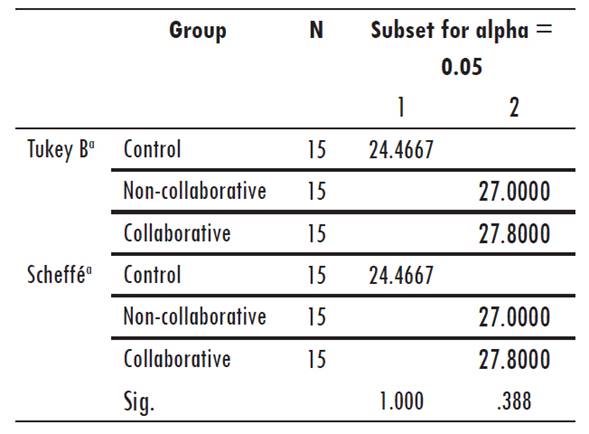
Means for groups in homogeneous subsets are displayed.
aUses harmonic mean sample size = 15.000.
As Table 4 indicates, the mean difference was significant between the control and collaborative as well as the control and non-collaborative groups. Therefore, there was a significant difference between the control and experimental groups. On the other hand, the significance value (sig=.388) was more than .05 between the collaborative and non-collaborative groups, indicating that the difference between these two experimental groups was not significant. These results confirm the first null hypothesis, which asserted that collaborative and non-collaborative reading strategy instructions do not impact reading comprehension differently.
Table 5 presents the results of the Duncan homogenous subset. As indicated in the table, collaborative and non-collaborative reading strategy instructions do not impact reading comprehension differently. In words, post hoc analysis showed that collaborative and non-collaborative groups outperformed significantly the control group, p˂ .05, whereas the two groups (collaborative and non-collaborative) did not differ from each other, significantly in attitude toward reading.
In order to check the second null hypothesis, which stated that collaborative and non-collaborative reading strategy instructions do not impact the participants’ attitude toward reading differently, a one-way ANOVA was conducted. Table 6 to Table 15 show the pretest results for the three groups.
As indicated in Table 6, the mean of the three groups was not statistically different for the pretest given before the instruction (mean=55.77). In order to check whether the variance in the scores was the same for each of the three groups, Levene's test for variance homogeneity was run. The results are illustrated in Table 7.
As indicated in Table 7, the significance value was greater than .05 (sig: .859), which means there was not a significant difference among the mean scores on the attitude pretest (p<.05). At the end of the treatment, the subjects were given the posttest. A one-way ANOVA was run using SPSS analysis version 21 on the posttest. The results are illustrated in Table 8.
As indicated in Table 8 and according to the confidence intervals, there were differences among the means of the control (x= 54.90), collaborative (x= 64.36), and non-collaborative (x=60.59) groups. To verify whether the differences were significant after the intervention, a one-way ANOVA was run. The results are presented in Table 9.
As indicated in Table 9, the significance value (.030) was less than .05, indicating that there was a significant difference somewhere among the mean scores for the dependent variables of the three groups on the posttest. In order to locate where the differences among the groups occurred, the Scheffé test was run on the posttest for multiple comparisons. The results are presented in Table 10 below.
Table 10 Multiple Comparisons for the Posttest on Attitude toward Reading
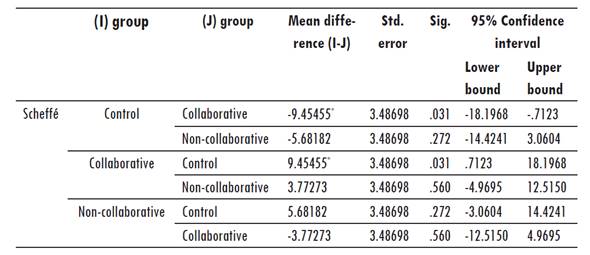
*The mean difference is significant at the 0.05 level.
As Table 10 shows, the effects were significant for the control and experimental (collaborative and non-collaborative) groups. The observed significance level is .560 between the collaborative and non-collaborative groups, indicating that the difference between these two groups was not significant. These results confirm the second null hypothesis, which asserted that collaborative and non-collaborative reading strategy instructions do not impact attitude toward reading differently.
Table 11 Homogeneous Subset for the Posttest on Attitude toward Reading
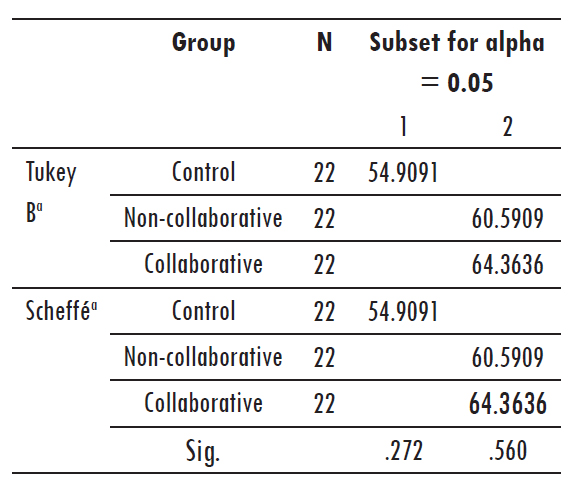
Means for groups in homogeneous subsets are displayed.
aUses Harmonic Mean Sample Size = 22.000.
Table 11 displays the results of the Duncan homogenous subset. As indicated in the table, the collaborative and non-collaborative reading strategy approaches did not have different impacts on the students' attitude toward reading. In words, post hoc analysis showed that collaborative and non-collaborative groups outperformed significantly the control group, p˂.05, whereas the two groups (collaborative and non-collaborative) did not differ from each other, significantly, in attitude toward reading.
To test the third hypothesis stating that collaborative and non-collaborative reading strategy instructional approaches do not have similar impacts on the four subcategories of attitude toward reading (comfort, anxiety, intellectual value, and practical value), the ranking of each attitude subcategory was determined using the Kruskal-Wallis test in both experimental groups. The data are presented in Tables 12 and 13.
Table 12 Kruskal-Wallis Test Statisticsa,b for the Reading Attitude Posttest Subgroups in the Non-Collaborative Group
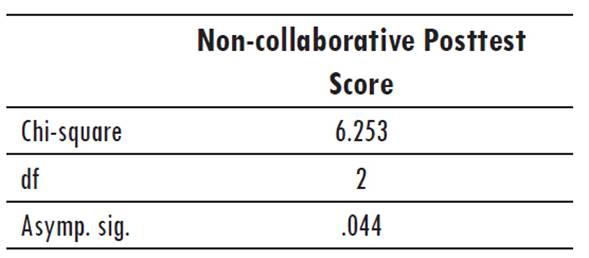
a Kruskal-Wallis test
b Grouping variable: Reading attitude subgroup scores
As indicated in Table 12, the significance value was less than .05; therefore, the results suggest that there was a statistically significant difference among the continuous variables across the groups. To determine the ranking of each attitude subgroup, Table 13 presents the mean rank for the non-collaborative group.
An inspection of the mean ranks in Table 13 indicates that comfort and anxiety had the highest and lowest mean rank for the non-collaborative attitude posttest, respectively.
The same procedure was conducted for the collaborative group to probe the ranking of each attitude subgroup. The results of the Kruskal-Wallis test for the attitude posttest subgroups of the collaborative group are presented in Table 14.
Table 14 Kruskal-Wallis Test Statisticsa,b for the Reading Attitude Posttest Subgroups in the Collaborative Group
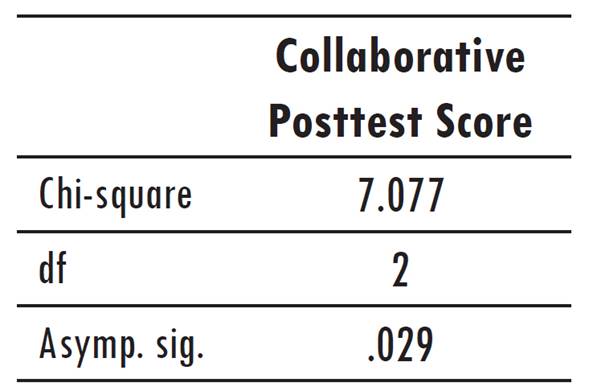
aKruskal-Wallis test
bGrouping variable: Reading attitude subgroup scores
As indicated in Table 14, the significance value (.029) is less than .05; therefore, the results suggest that there was a statistically significant difference among the continuous variables across the groups. For an examination of the ranking of the attitude subgroups in the posttest for the collaborative group, Table 15 presents the collaborative group’s mean rank.
Table 15 shows that intellectual value and anxiety had the highest and lowest mean ranks of the attitude subgroups in the collaborative posttest, respectively. Therefore, the third hypothesis is accepted, indicating that the four different subgroups examined in the attitude questionnaire are impacted differently in collaborative and non-collaborative strategy instruction. The mean rank from highest to lowest for the non-collaborative group was comfort, intellectual value, practical value, and anxiety, and for the collaborative group it was intellectual value, comfort, practical value, and anxiety.
Discussion and Conclusion
Analysis of the data collected through the reading comprehension test and the questionnaire on attitude toward reading showed that reading strategy instruction, regardless of the collaborative or non-collaborative nature of the approach to teaching reading strategies, affected gains in the two experimental groups when compared to the control group. Conversely, no differences were observed between the means of the two experimental groups, showing that the collaborative or non-collaborative nature of teaching reading strategies itself has no significant effect on gains in reading comprehension or boosting attitude toward reading.
Regarding the four subcategories of the attitude questionnaire, differences did appear. In the collaborative group, intellectual value had the highest mean rank, while in the non-collaborative group, comfort had the highest mean rank. Though this ranking shows that the four attitude subcategories were affected differently, a cursory look at the ranking pattern shows that the difference between the two groups was not very great. The mean ranks from highest to lowest were comfort, intellectual value, practical value, and anxiety for the non-collaborative group and intellectual value, comfort, practical value, and anxiety for the collaborative group. In other words, in the non-collaborative group the top two ranks were comfort and intellectual value and in the collaborative group the top two ranks were intellectual value and comfort. The third and fourth ranks were the same in both groups.
As Alexander and Jeton (2000) state, students who are taught strategies start to think metacognitively about strategies to improve their reading. Findings of the present study resonate with several other studies, e.g., Ghaith and Amal (2003); Jacob, Rottenberg, Patrick, and Wheeler (1996); Khezrlou (2012); Shokrzade (2010); and Zarei (2012). Shokrzade (2010) studied the impact of metacognitive strategies and critical thinking ability on learner comprehension and found that metacognitive strategy instruction had a positive impact on learners’ reading comprehension. Jacob et al. (1996) found that cooperative learning activities allowed students to ask their group members questions and discuss the answers to these questions, which can lead to much less anxiety in them. Employing a set of comprehension strategies designed to improve understanding of expository texts, Klingner et al. (2004) conducted a study involving five intervention and five control teachers from five different schools along with their students in order to examine the teachers’ yearlong use of CSR. Results evinced that students who received strategy intervention in CSR classrooms improved significantly in reading comprehension when compared with their counterparts in control classrooms. It was also found that comprehension gains were associated with the quality of CSR implementation by the teachers. In another study, Zoghi, Mustapha and Maasum (2010) investigated the applicability and effectiveness of the Modified Collaborative Strategic Reading (MCSR) with 42 university-level Iranian EFL freshmen by using a pretest-posttest design. They gave reading instruction according to MCSR, and the results showed that students held positive attitude toward MCSR. They concluded that, despite popular thinking at the time in the Iranian EFL context, which disapproves of group work due to traditional beliefs, EFL students had a strong preference for communicative and cooperative activities.
The current study revealed that the non-collaborative approach to teaching strategies is as effective as the collaborative approach in improving reading comprehension and attitude toward reading. However, the use of collaborative instruction is still more highly recommended if classroom circumstances are favorable. Investigating perceptions of and attitude toward student centered learning among higher-education students, Lea et al. (2003) conducted a study using focus group interview and Internet questionnaire data collection procedures and found that students generally had a very positive attitude about student centered learning. However, as the application of student-centered learning may not be easily applicable in all contexts, the researchers' concern was about the adequacy of current resources to support the effective application of such an approach. This study found that in the event that the employment of a collaborative approach to teaching reading is not feasible, the non-collaborative approach can be employed as they have the same positive effects as long as the reading course is strategy-based.
Pedagogical Implications
In his model of reading attitude acquisition, McKenna (2001) asserted that each reading experience makes a difference in one’s attitude toward reading and one’s beliefs regarding reading outcomes. Positive attitudes toward cooperative approaches may indirectly change learner attitudes toward language learning and encourage their interest. As Cangelosi (2000) suggested, cooperative learning activities lead to student engagement in lessons and help them to improve their intrinsic motivation. In language classrooms where the students work in groups, anxiety is lowered; therefore, self-confidence and self-esteem are enhanced, and a positive attitude toward learning is created (Cangelosi, 2000). Students with better attitudes in the language classroom tend to use the target language more, which helps them improve their language proficiency (Johnsen, 2009). The current study has shown that strategy instruction can have considerable positive effects on learners' reading comprehension and attitude toward reading, regardless of whether it is delivered using collaborative or non-collaborative approaches. Therefore, while there are benefits to employing the cooperative approach to teaching reading, if it is not possible, the cooperative and non-cooperative learning approaches could be mixed as needed because they both could improve learners' reading comprehension and attitude toward reading.
All in all, there are many reasons that can motivate instructors to use cooperative learning techniques, including increased interaction in the classroom among students. However, there are some contextual factors which may influence the applicability of cooperative methods, such as the availability of teachers familiar with the basic features of cooperative learning, the number of students, the characteristics of the students (for example, age or gender), the time available for each class, and course requirements.
The educational system in Iran is largely individualistic and competitive. In such a system, it may be very difficult to convince learners to learn in cooperative groups and learn from each other, particularly when they know they will be tested individually. The findings of this study can save teachers from a state of ambivalence about choosing collaborative or non-collaborative methods to teach reading when the course is strategy based. Both methods proved to be effective and beneficial. Considering the practicality issues when it is difficult to implement collaboration in the classroom, and to avoid the possible disadvantages and difficulties of cooperative classes, individualized methods can be used because they are as effective as the collaborative ones.
In addition, as students often find reading unattractive and difficult, there is a need to find innovative ways to help them stay interested in it and retain the intention to read and continue reading (Mathewson, 2004). Findings from this study have shown that, a) by reading in groups the students had less anxiety and more willingness to read their texts as they believed reading would enhance their intellectual capabilities, and b) by reading individually they felt more comfortable with the reading texts. Both increased their positive attitude and finally caused them to like reading more.
Zarei (2012) investigated the effect of cooperative activities on Iranian learners' reading comprehension, and his study did not confirm a superior effect of cooperative learning over non-cooperative learning with respect to reading comprehension among advanced general English proficiency level students. He found that low proficiency level students gained more from communicative activities than the more advanced students. As the students of the current study were at mid-level of reading proficiency as determined through the reading test, it is suggested that this study be conducted on learners of other reading proficiency levels and compare the results with the results of the current study in both reading comprehension ability and attitude toward reading. It is also suggested that the same study be conducted in non-competitive EFL and ESL contexts to see if learners in such contexts show the same or different results. As the participants in this study were female English learners, it is also recommended that gender differences be considered for further research.














